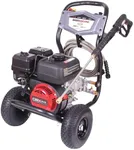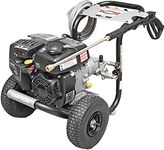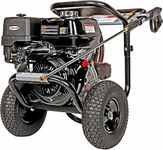Buying Guide for the Best Gas Pressure Washers
Choosing a gas pressure washer can make outdoor cleaning tasks much easier, from washing driveways and decks to cleaning vehicles and siding. The right model for you depends on what you plan to clean, how often you’ll use it, and how much power you need. Understanding the main features and specifications will help you select a washer that matches your needs and ensures safe, effective cleaning.PSI (Pounds per Square Inch)PSI measures the water pressure produced by the washer, which determines how forcefully the water hits the surface. Higher PSI means more cleaning power, which is useful for tough stains or large areas. Light-duty tasks like washing cars or patio furniture usually require lower PSI (around 2000), while medium-duty jobs like cleaning fences or decks benefit from mid-range PSI (2500-3000). Heavy-duty cleaning, such as stripping paint or cleaning concrete, may need PSI above 3000. To pick the right PSI, think about the toughest job you’ll need to tackle and choose a washer that meets or slightly exceeds that requirement.
GPM (Gallons per Minute)GPM tells you how much water the washer uses each minute, which affects how quickly you can clean a surface. A higher GPM means more water flow, helping you rinse away dirt faster. For small, occasional jobs, a lower GPM (around 2) is usually enough. For larger or more frequent cleaning, a higher GPM (2.5 or more) will save time and effort. Consider the size of the areas you’ll clean and how quickly you want to finish when deciding on GPM.
Engine Size (CC)The engine size, measured in cubic centimeters (CC), indicates the power of the gas engine. A larger engine can handle higher PSI and GPM, making it suitable for demanding tasks and longer use. Smaller engines (around 160cc) are lighter and easier to move, good for lighter jobs. Medium engines (180-200cc) balance power and portability, while large engines (over 200cc) are best for heavy-duty, frequent use. Match the engine size to the intensity and frequency of your cleaning tasks.
Nozzle TypesNozzles control the spray pattern and pressure, allowing you to adjust the washer for different tasks. Most washers come with several color-coded nozzles, ranging from a narrow, powerful stream to a wide, gentle spray. Narrow nozzles (0-15 degrees) are for tough stains, while wider nozzles (25-40 degrees) are for general cleaning and rinsing. Some washers include a soap nozzle for applying detergent. Choose a washer with a good selection of nozzles to handle a variety of cleaning jobs safely and effectively.
Hose Length and MaterialThe hose length affects how far you can move from the washer without repositioning it, while the material impacts durability and flexibility. Short hoses (under 25 feet) are fine for small areas, but longer hoses (25-50 feet) are better for reaching around vehicles or large patios. Hoses made from reinforced rubber or steel-braided materials last longer and resist kinks better than basic plastic hoses. Think about the size of your cleaning area and how much movement you’ll need when choosing hose length and material.
Portability and Frame DesignPortability refers to how easy it is to move the washer around your property. Look for features like large wheels, sturdy handles, and a balanced frame, especially if you’ll be moving the washer over uneven ground or up and down steps. Compact, lightweight models are easier to store and transport, while larger, heavier models may offer more power but require more effort to move. Consider your storage space and how often you’ll need to move the washer when evaluating portability.
Detergent SystemMany gas pressure washers have a built-in detergent tank or a siphon hose for applying soap. This feature makes it easier to clean surfaces that need more than just water, like cars or siding. Some systems automatically mix detergent with water, while others require manual mixing. If you plan to use soap often, look for a washer with a convenient and easy-to-clean detergent system.












